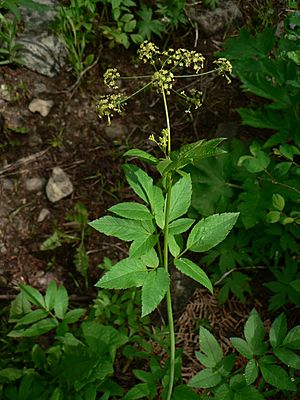Western sweet cicely facts for kids
Quick facts for kids Western sweet cicely |
|
|---|---|
 |
|
| Scientific classification | |
| Genus: |
Osmorhiza
|
| Species: |
occidentalis
|
Osmorhiza occidentalis is a type of flowering plant. People often call it western sweet cicely or western sweetroot. It belongs to the Apiaceae family, which also includes carrots and parsley.
This plant naturally grows in western North America. You can find it in places like the Northwestern United States and California. It likes to live in damp, wooded areas and forests. It is most common in mountain forests, usually between 1,200 and 3,000 meters high.
What Does Western Sweet Cicely Look Like?
Western sweet cicely is a plant that stands tall. It can grow to be over 1 meter (about 3 feet) high. It is a perennial herb, which means it lives for more than two years.
Its green leaves can be up to 20 centimeters (about 8 inches) long. Each leaf is divided into smaller parts called leaflets. These leaflets have jagged edges, like tiny teeth. The main part of the leaf sits on a long stalk called a petiole.
The plant produces many tiny, yellowish flowers. These flowers grow in a cluster at the top of a stem. This cluster is shaped like an umbrella and is called an umbel. After the flowers bloom, the plant grows long, thin fruits. These fruits can be up to 2.2 centimeters (about 0.8 inches) long.
How People Used This Plant
Many Native American groups used western sweet cicely. They found many ways to use this plant for medicine. They used different parts of the plant to help with various health issues.

